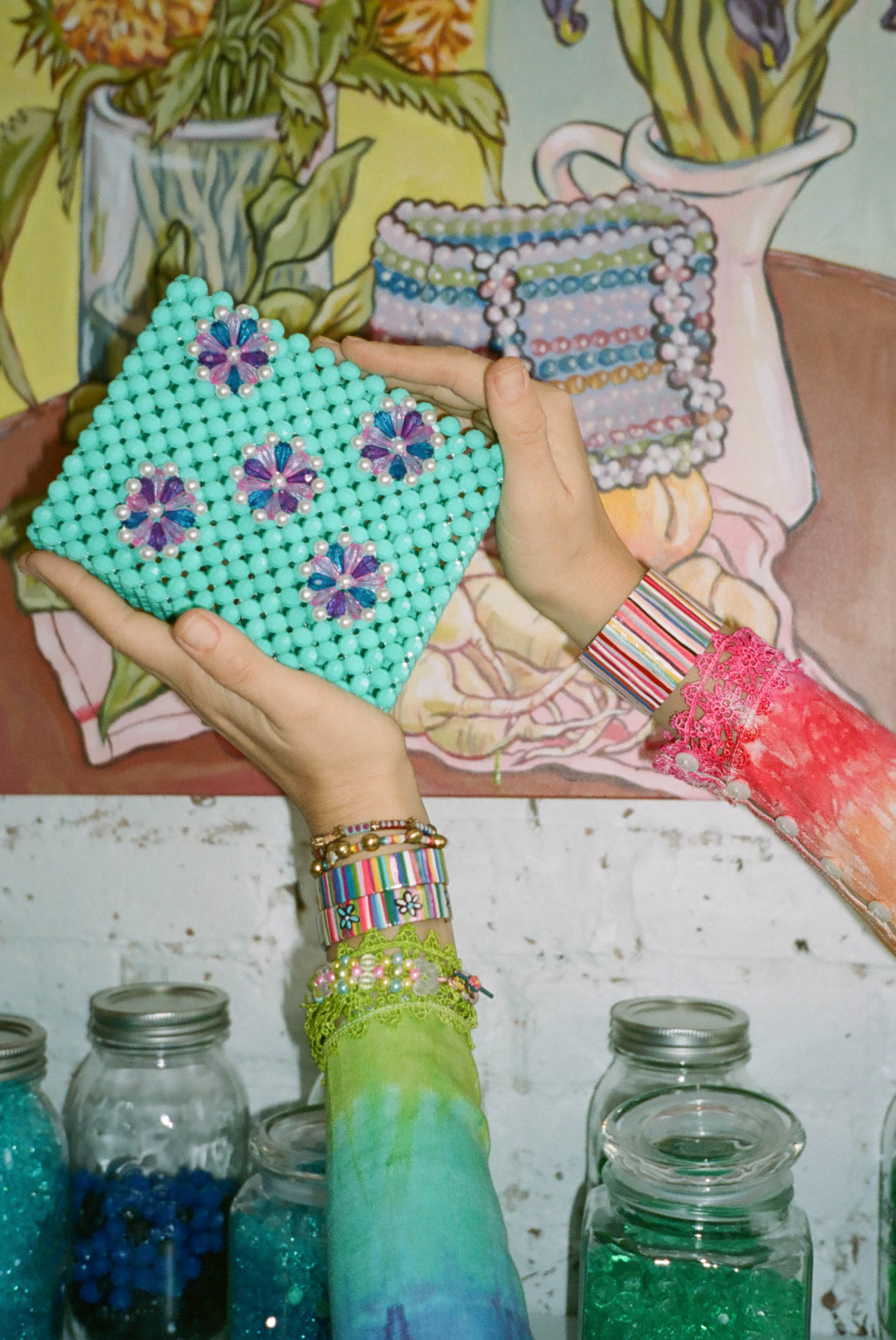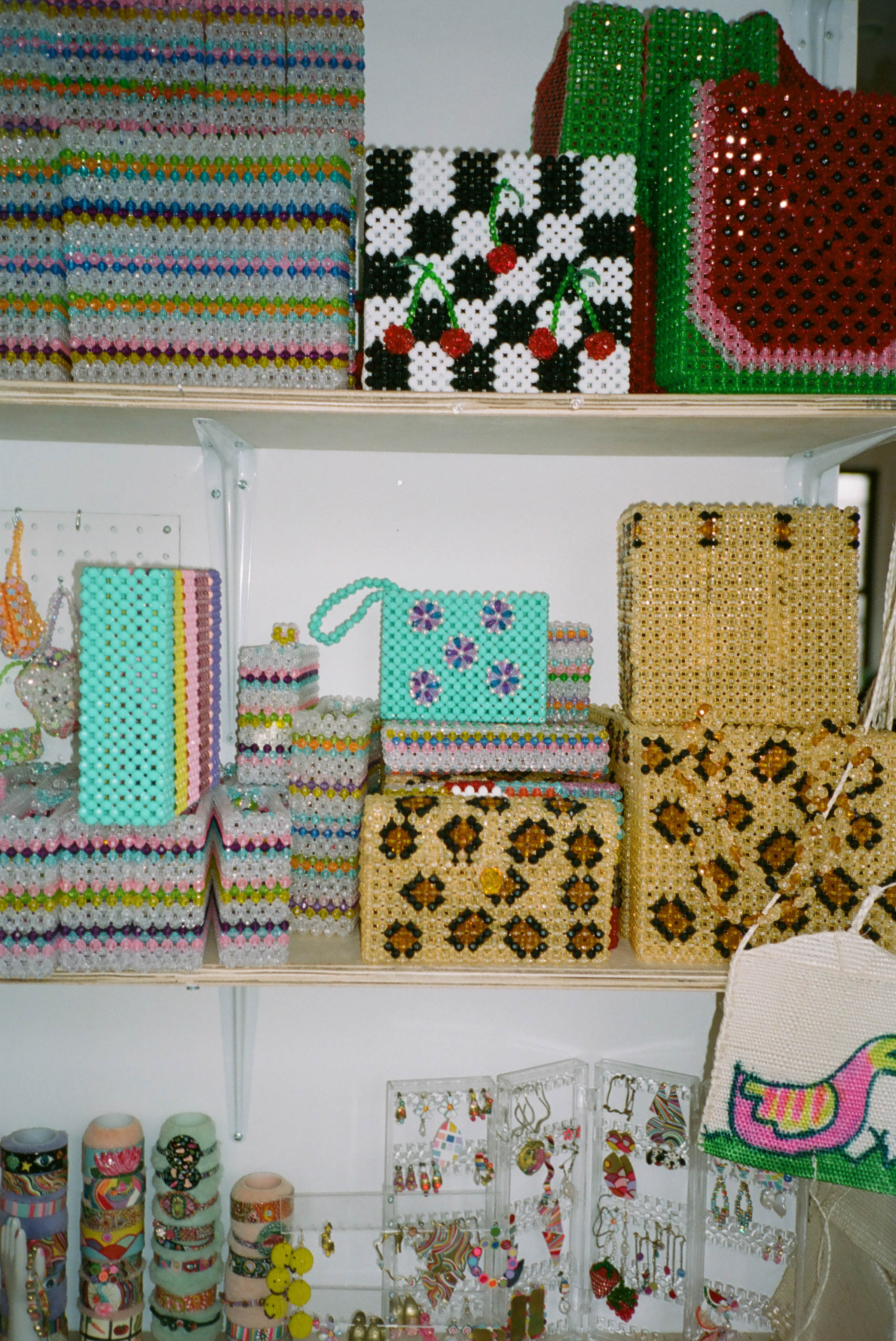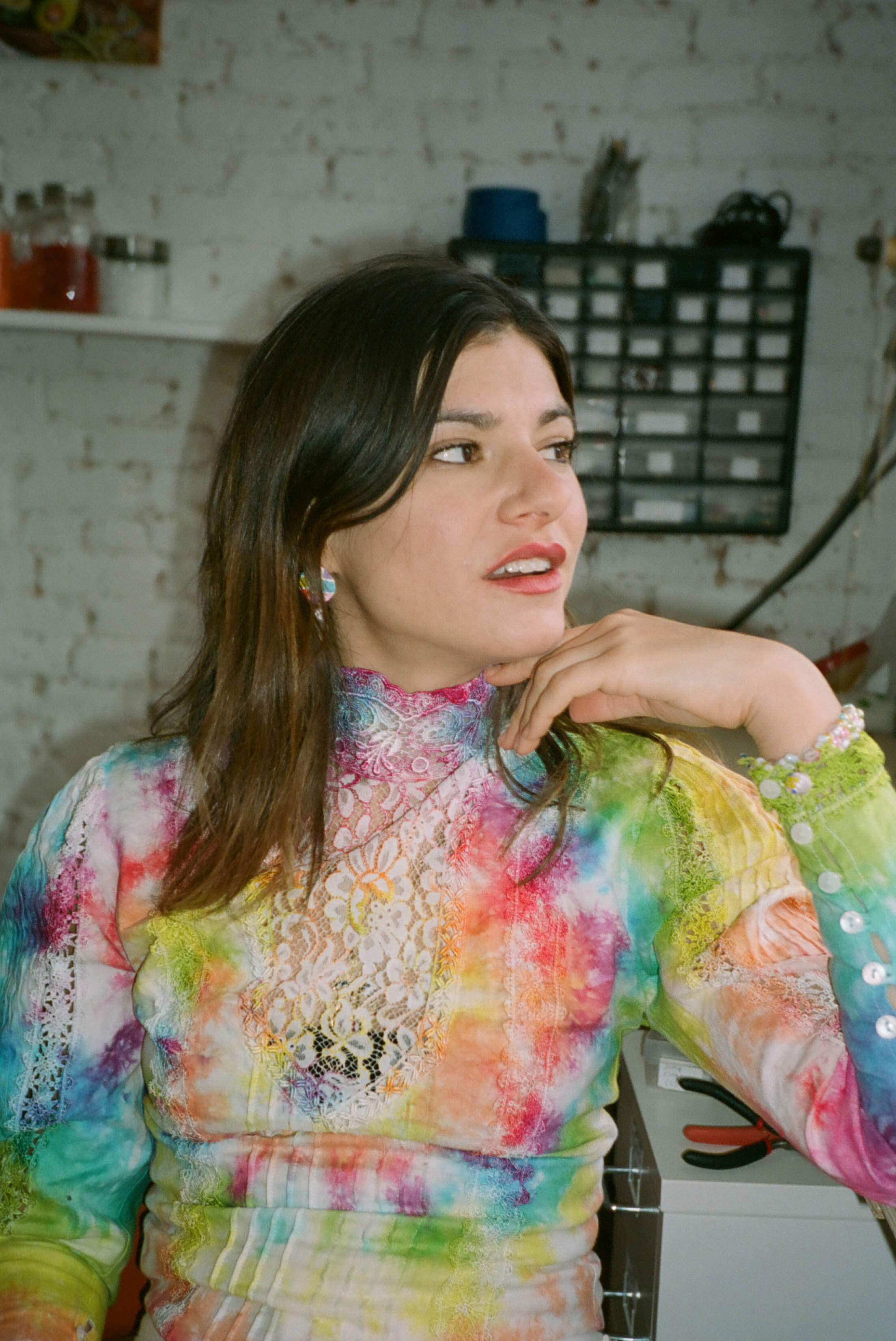“Susan Alexandra is a jewelry and accessories designer based in New York City. She is also someone who is incapable of putting up a front, never afraid to ask for help, and a proud Scorpio. ”
Growing up in Columbus, Ohio, Susan Alexandra’s imagination quickly bloomed to fill the corners of an everyday life with bright color. She soon developed a dream to work in the fashion industry, with a handful of certainties in mind: first, her work would focus on creating joy; second, she would be her own boss and work on her own timetable. Despite her conviction, Susan didn’t avoid struggle. After moving to New York City in 2009 to pursue her career, she found herself lost and frightened, unsure of her next step in the city’s elite fashion landscape. Searching for some levity, she began taking jewelry classes, and ended up allowing her joy to lead her into a full-time career as a designer.
Beginning with hand-painted jewelry, Susan would go on to expand her brand with a rainbow range of glowing, beaded bags that have since exploded on Instagram and been scooped up by editors and celebrities alike. Uninterested in calculated marketing strategies or achieving mass appeal, Susan has grown her label from the ground up through genuine relationships and connections, engaging in honest and intimate exchanges with her customer base and turning the phrase, “friends of the brand” into a literal business model.
Currently based in New York City’s Chinatown, Susan and her tight-knit team make bright, whimsical creations that aim to delight the wearer and harken back to a time of childhood imagination. On a cold December day, we were invited into Susan’s studio, where we got the details of her near-cinematic New York City tale of hard times, grit, chance encounters and triumphs.
Where did you grow up?
I grew up in Columbus, Ohio where there isn't a lot of visual stimulation. I think coming from a place that lacks a lot of culture forces you to create your own dream world. I watched a lot of TV and films that have left lasting impressions on my aesthetic, like "Pee Wee's Playhouse" and Tim Burton movies.
Can you describe your approach to design in one sentence?
Make things that bring you joy.
How did you break into the fashion industry?
I moved to new York in 2009, and I thought that I wanted to be a stylist. It turned out to not be a fit at all, and I was really lost because I thought styling was my path. I was definitely at a crossroads, and I started taking jewelry classes on the weekends, just because I’ve always loved crafting. It was nothing serious. During these classes, I learned that I wasn’t that good, but I still wanted to make it work. So, to cover up all the errors in the metal jewelry I was making, I started painting over the mistakes. I ended up unintentionally creating a unique style, and people started asking me where I got the pieces I was wearing. Eventually I put up a website and people started buying my pieces, and that’s how I got my foot in the fashion world. I still feel like an outsider.
Why do you feel like an outsider?
I think that the fashion world is a very exclusive, elite group of people who appear to have all the answers and no fears about money. I’ve met so many people who are at different levels at their careers, and there are some people who just have an invulnerable attitude; people who say things like “everything is fabulous” and “all the celebrities want my pieces.” In contrast, I’m very open and vulnerable. I’m saying things like “I’m scared every day” and “I’m working so hard that I’m exhausted.”
The older I get and the more time I spend in the fashion world, the more I realize it’s mostly smoke and mirrors. Everyone is struggling and everyone is working really hard. I’ve been working to create a community where everyone feels included, and I think I’ve found a community where everyone is very open with their struggles. It makes me feel not so alone. Those are the people that I think are re-defining what the fashion industry, at least in New York, can be.
What do you think makes your work stand out?
I feel that my use of color and whimsy give my work a pop that stands out from the crowd. I also feel like there is so much heart and emotion that goes into my work, and that people really resonate with that level of authenticity.
How did you know what you wanted to do with your life?
I feel like part of living in New York is having a public breakdown on the subway. When I was feeling really lost during my first years in New York, I was doing just that and I remember thinking, “if I can figure out a way to give guidance and mentorship to people exactly like me, who are absolutely lost and feel that they have no community and are just super scared, then I know that’s my purpose.” I had a very clear vision that what I was supposed to do was to help young women who are lost and trying to figure out where they belong in the world. That’s still my goal, and I’m still trying to figure out how I can make that space with the work that I create.
Have you ever looked into business loans or any other kind of funding?
I didn’t take any business loans when I started, but I’m in the process of trying to secure some funding now. You really do need money to run a business, especially when you’re doing volume.
So you started with jewelry, how did you get into bags?
I live in Chinatown, and I was walking my dog one day when she took me down a different street. I passed by this ground-level room with a glass door, and I saw that the inside was packed with bags of colored beads. I felt compelled to go in. It turned out to be the storage room for a retirement home, and the beads were all for crafts that help the residents with things like arthritis. There were all of these beaded creatures out, like lizards and dogs, and it was such beautiful work. I asked a woman inside, whose name is Lisa, if she would do a custom design, but there was a language barrier and we weren’t understanding each other. I was about to give up when Lisa brought out her 10-year-old son to translate; I asked her if she could make a bag and she agreed. I sketched out a design on the spot and picked out the bead colors. I came back a week later, and my bag was ready and perfect.
I made the bag for myself, and I put it on my Instagram story. I had never received so much feedback for anything I had ever posted, and I’d had my jewelry business for two or three years at that point. I knew I had stumbled on something. Lisa went on to become my lead manufacturer. She and I are very compatible, so something I paint in watercolor, she can translate and bead together, color and all. I absolutely believe that everything that happened that day happened for a reason, but I also think it was a very New York thing – to have one interaction on the street change the course of your life.
How did you learn about production and manufacturing?
I’m still learning! I’m completely self-taught, and figuring out production has been one of my biggest challenges. I ask everyone I know for advice, and I’ve been very lucky to meet the women who I work with now. I literally met the woman who makes my bags while I was walking down the street, so I basically fell into one of my manufacturers. I’m now seeking to expand my production both in the U.S. and overseas, and it’s been very difficult to do so on a limited budget.
You’re a busy person, how do you find balance?
For a lot of designers I’ve talked to, finding a balance between business and creative time is a constant struggle. For me, I think it comes down to my mindset. I’m working to recognize that I’m not a robot, and I can only do so much in one day. I don’t need to solve every single problem and respond to every single email. Instead, I want to allow myself the time to create, and allow other people on my team to take care of small things. It’s a mixture of relinquishing control and allowing myself some freedom. I feel I need to create stronger boundaries for myself.
Do you ever deal with imposter’s syndrome, fomo, fatigue, that kind of thing?
I deal with these things every day, but the older I get, the easier they are to deal with - especially the FOMO; the fashion biz is built on FOMO. I am learning to lean into my power more, and to reflect on and appreciate all the growth and accomplishments of my business. The fatigue is never-ending. I am trying to find ways to be less depleted because I so very much need my emotional and physical energy to run this business.
What is your typical day like?
I try to do a workout class in the morning, because it makes me feel so much better about myself for the rest of the day. When I come back, I’ll take care of emails in my apartment. At around 1 p.m., I’ll go to the studio to meet with my team and take care of a list of tasks that changes every day. I work there for about nine hours every day, and then I come home and pass out. My schedule is definitely defined by work.
What are your favorite workout classes?
I absolutely love to do Aqua Studio’s aqua cycling class in Tribeca. It’s so fun, and it’s very low impact. Plus, it’s just nice to be in the pool. I also love taking Everyday Ballet classes, because it requires such intense focus that it takes my mind off of everything else.
Do you have an approach to getting press?
My philosophy is this: I want people to connect with my work in a natural way. I feel so much press is born from giving people free stuff, even though they don’t know anything about your work or your story. I focus on making relationships with people, and I love to give gifts to the people who love and support my work, just as a thank you. My approach has been to create relationships with people that are based on more than just my business. Through these relationships, I have a lot of people who promote my stuff and are rooting for me, and that’s been really helpful.
Do you have an instagram strategy?
I like to show a window into my world with a strong voice, and I try to post twice a day. My Instagram feed is made up of pictures of jewelry and bags; my stories are much less scripted. They are very day-in-the-life, so it’ll maybe be a picture of my dog or a pot I just bought. I like this approach because I personally connect more with brands who let us know a little more about the creator. What separates smaller designers from these huge brands is who we are.
I think it’s really interesting that instagram has become such an important platform for a lot of businesses. How do you approach networking on Instagram?
This business is so connected to me, and I am physically and emotionally unable to put on a front or a show. When I reach out to people, its from a genuine place. I’m very real with them about how much of a fan I am and how much I would love to work with them. I think my biggest key to success is keeping it honest, because there’s so much fake stuff in this world. People love authenticity. It also helps to reach out to people who you think would be into your work.
I respond to Instagram stories a lot, and I try to learn about the person instead of giving them a robotic monologue. I think it’s important to not necessarily ask for something transactional, but to instead develop a relationship and learn what they’re into and what they like.
When you were starting out, did you ever cold-call any editors or retailers?
When I first started my business, I would reach out to every store and every editor and I get zero responses. I think it’s important to not be deterred by lack of response, because it really all comes down to one person giving you a chance. Today, every store I reached out to in the beginning now carries my work, but at the time it really broke me. In the end, it’s all very full-circle and you just have to trust that the timing and the process is happening the way it’s supposed to.
What would you say was your first big break?
When I first launched the bags, I got an email from Opening Ceremony and that really set everything in motion to bring my company to what it is today.
When that happened, I wished so badly that I could tell my younger self that all of her pain and fear wasn’t for nothing. It was a very profound and reflective moment.
People in the entrepreneurial world often say to “do things that scare you,” but that can seem pretty general when you’re starting out and are kind of scared of everything. How would you define a good “something that scares you” moment?
I am constantly asking myself, "does this scare me because it's outside of my comfort zone, or does it scare me because it's insane?" I think that will always be an ongoing question. Talk to people who know better and let them weigh in, but ultimately, go with the answer that makes you feel the best. This can change from day to day.
How do you ask for help?
I’m not a strategic person, I’m just very honest. If I need help, I will tell anyone that I know who is in the business that I’m struggling. Sometimes people don’t respond well to that, but they are usually people who have a lot of money and a big support system. But other people, like my friends who are independent designers, will know exactly what I mean, and they want to help me and give me recommendations or advice. Most of the time people want to help you, so I think everyone should feel less afraid of asking.
How do you get inspired?
I know it sounds cheesy, but I don’t seek inspiration, it usually just comes to me. Right now, for example, I’m obsessed with butterflies and I want to do so much with them. I do try to not look at what other people are doing, because I don’t want to be influenced at all.
How do you stay motivated?
There is a fire burning within me. Sometimes the flames are huge and insatiable; sometimes, they're just embers. It comes in waves. Usually, what gives me motivation is just feeling excited about an idea.
Would you do anything differently if you were just starting out today?
I don't have any regrets when it comes to my approach, but it would have been nice to have created an infrastructure. My company began as an art practice for me and I never built out systems. I wish I had invested in that early on.
What advice would you give to a beginner designer?
I would tell them that it is a wild new time in fashion where the old rules no longer apply, and you don't have to be liked or accepted by the old guard to show your work. We have so much power in what we put into the world, and we don’t need permission to express our visions and stories. In summary, even if you feel like an outsider, you have the power to create and make your own rules. Even if you don’t see immediate results, keep going. Keep making and producing and putting your work into the world. I really believe that the right people will always see your work. Have faith in that.
What music are you listening to?
1970s Ethiopian jazz
What are you reading?
Franny and Zooey by J.D. Salinger
The Ayurvedic Cookbook by Amadea Morningstar with Urmila Desai
My Brilliant Friend by Elena Ferrante
What are your favorite movies?
Amelie by Jean-Pierre Jeunet
Ghost World by Terry Zwigoff
Annie Hall by Woody Allen
Margot At The Wedding by Noah Baumbach
Frances Ha by Noah Baumbach
You've Got Mail by Nora Ephron
What are your favorite places in the city?
Best Chicken Pho: LoveMama
Best Shopping: Opening Ceremony and American Two Shot
Best Borscht: B&H Dairy (also try the tuna platter)
Best Coffee: Cafe Integral
Best Facial: Rescue Spa
Best Cinema: Angelika Film Center
Best Skincare Products: Biologique Recherche Lotion p50,Biologique Recherche Serum Placenta
Best Holistic Healer: Gabrielle Francis
Best Workout Classes: Aqua Studio and Everyday Ballet
Best Apothecary: Flower Power
Words by Gabriella Lacombe











